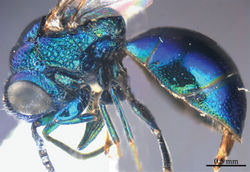Omalus pseudoimbecillus
| Notice: | This page is derived from the original publication listed below, whose author(s) should always be credited. Further contributors may edit and improve the content of this page and, consequently, need to be credited as well (see page history). Any assessment of factual correctness requires a careful review of the original article as well as of subsequent contributions.
If you are uncertain whether your planned contribution is correct or not, we suggest that you use the associated discussion page instead of editing the page directly. This page should be cited as follows (rationale):
Citation formats to copy and paste
BibTeX: @article{Wei2014ZooKeys407, RIS/ Endnote: TY - JOUR Wikipedia/ Citizendium: <ref name="Wei2014ZooKeys407">{{Citation See also the citation download page at the journal. |
Genus: Omalus
Name
Omalus pseudoimbecillus Wei, Rosa, Liu & Xu, 2014 sp. n. – Wikispecies link – ZooBank link – Pensoft Profile
Material examined
Holotype: ♀ (SCAU), Yunnan, Yimen, Longquan Park (24°40'5"N, 102°9'2"E), 12.II.2005, He-sheng Wang, No. SCAU-O0041. Paratypes: 1 ♀ (SCAU), Yunnan, Yunlong, Tianchi National Nature Reserve (25°52'4"N, 99°17'25"E), 21.VIII.2003, Peng Wang, No. SCAU-O0042; 1 ♀ (SCAU), Yunnan, Jingdong, Jingping (24°27'14"N, 100°50'4"E), 28.IV.2005, He-sheng Wang, No. SCAU-O0043.
Diagnosis
Omalus pseudoimbecillus sp. n. is similar to Omalus imbecillus based on the colouration, polished mesoscutum, and oval metasoma. However, it can be distinguished from the latter by having the tegula transparent brownish, with faint metallic reflections anteriorly (fully metallic blue in Omalus imbecillus); mesopleuron with striae between punctures (without striae in Omalus imbecillus); propodeal angle distinct and stout (indistinct in Omalus imbecillus).
Description
Female (n = 3). Body length 3.9–4.4 mm (Plate 13). Fore wing length 3.3–3.6 mm. MS = 1.4 MOD. Head. Face with large, round, dense (0–0.5 PD), shallow punctures (Plate 14A). Scapal basin deep, smooth, glabrous (Plate 14A). Ocellar triangle isosceles. Postocellar line absent (Plate 14B). Gena with oblique wrinkles. Mesosoma. Pronotum almost impunctate medially, with small, deep pits on anterior margin; with large, dense (0–0.5 PD) punctures laterally (Plate 14B). Mesoscutum polished, almost impunctate (Plate 14D); notauli indistinct but complete, impressed as fine lines, with notaulic pit round and short; parapsidal lines indistinct (Plate 14D). Scutellum with two flattened, semi-elliptical foveae on anterior margin (Plate 14D); with broad, impunctate median area extending along its length (Plate 14D); areolate-punctate laterally, becoming deeper, larger towards alar foveae (Plate 14D). Mesopleuron with striae between punctures (Plate 14C). Metanotum gibbous, with large, deep, areolate-reticulate punctate (Plate 14D). Propodeum with lateral margin concave before propodeal angle; propodeal angle distinct, stout, pointing posterolaterally. Tarsal claw with three teeth.
Metasoma. Oval (Plate 14E), L/W = 15/11. T-I and T-II almost impunctate dorsally, with fine, scattered punctures laterally. T-III with fine, denser punctures than those on T-II (Plate 14E); apex of T-III with narrow (1/3 MOD), testaceous semi-transparent rim, without median notch (Plate 14F).
Colouration. Face metallic blue. Vertex and mesosoma purple, with mesoscutum blackish, and mesopleuron metallic bluish-green or green. Antenna black, with scape and pedicel metallic green. Tegula transparent brownish, with faint metallic reflections anteriorly. Leg metallic greenish-blue, with tarsus testaceous. Metasoma blackish-purple, with metallic blue reflections.
Male. Unknown.
Distribution
China (Yunnan).
Biology
Unknown. Collected in February, April, and August.
Etymology
The name pseudoimbecillus is derived from the Greek word psèydos (false) and the chrysidid name imbecillus. This name points to the morphological similarity between the two species.
Original Description
- Wei, N; Rosa, P; Liu, J; Xu, Z; 2014: The genus Omalus Panzer, 1801 (Hymenoptera, Chrysididae) from China, with descriptions of four new species ZooKeys, 407: 29-54. doi
Images
|

